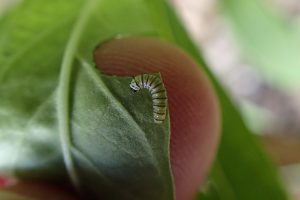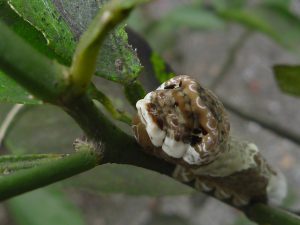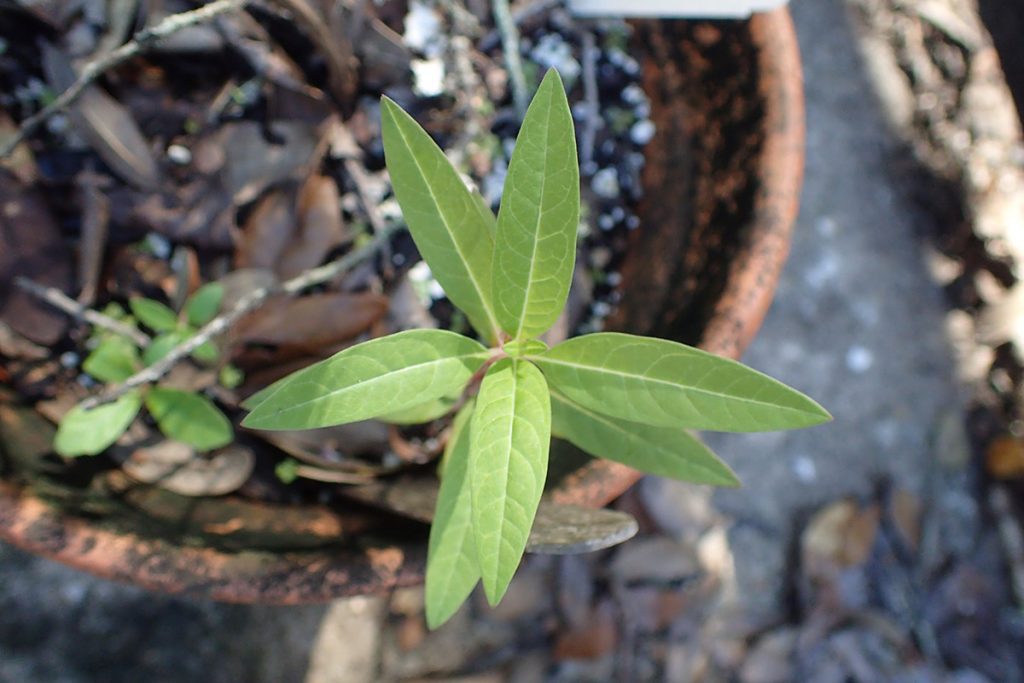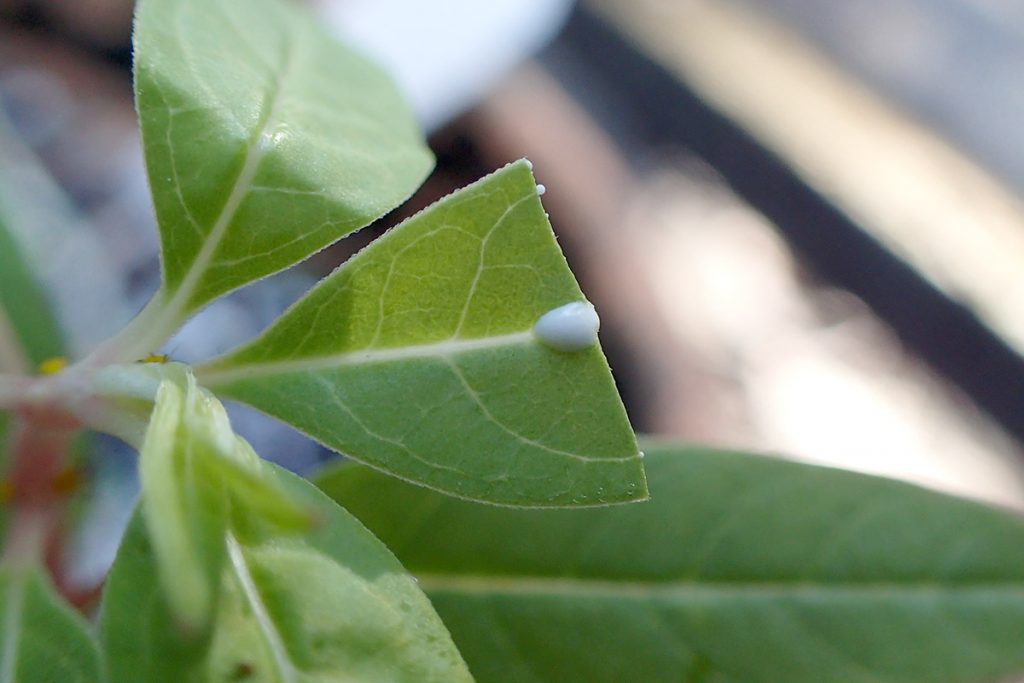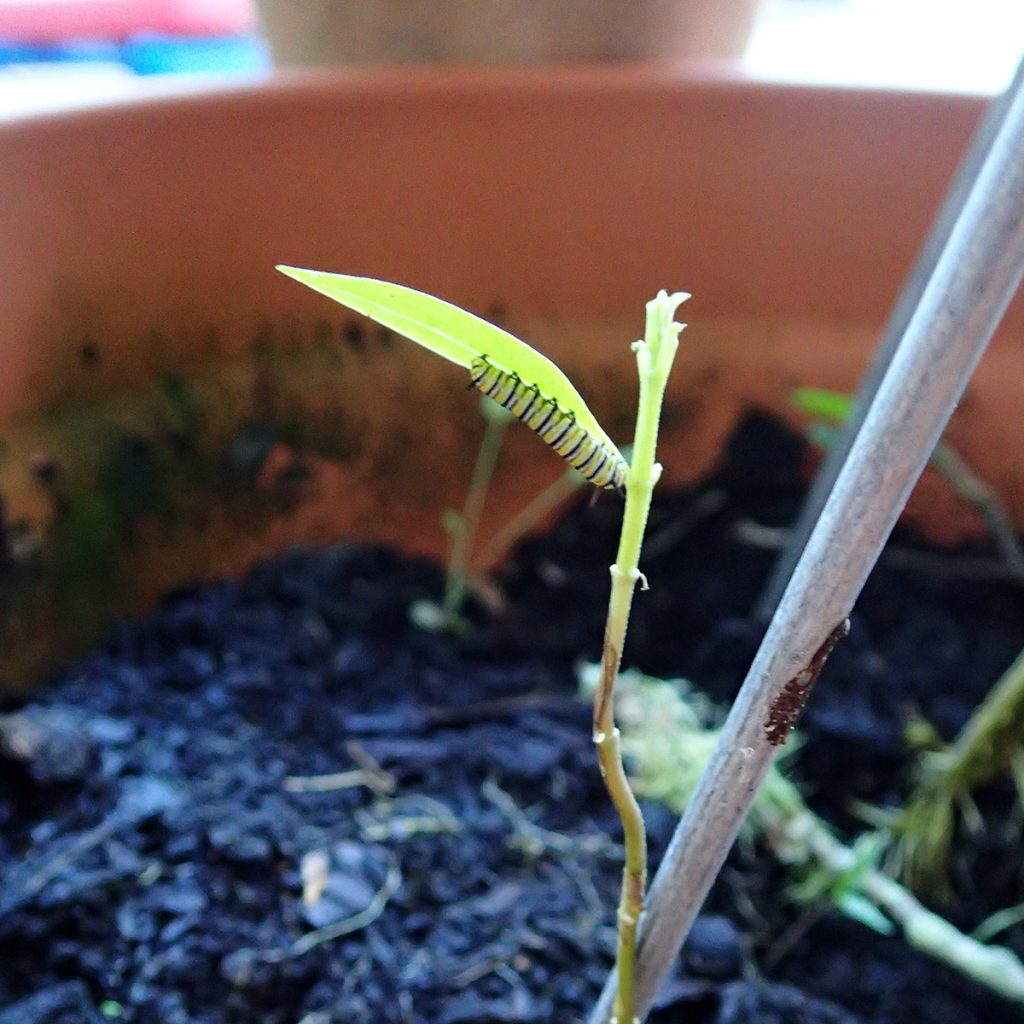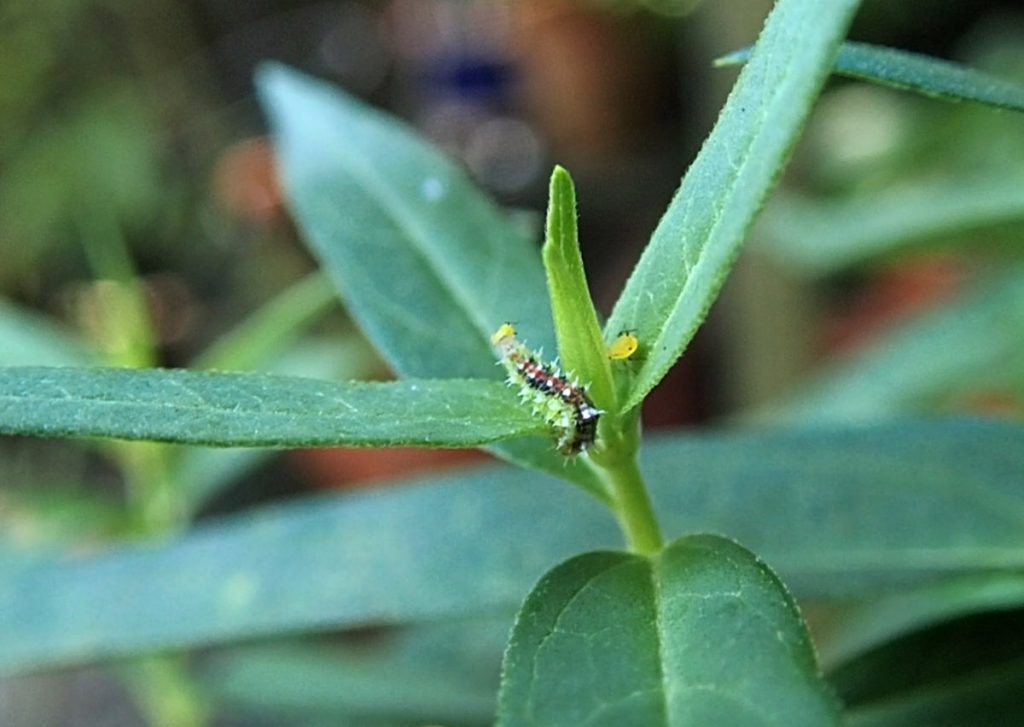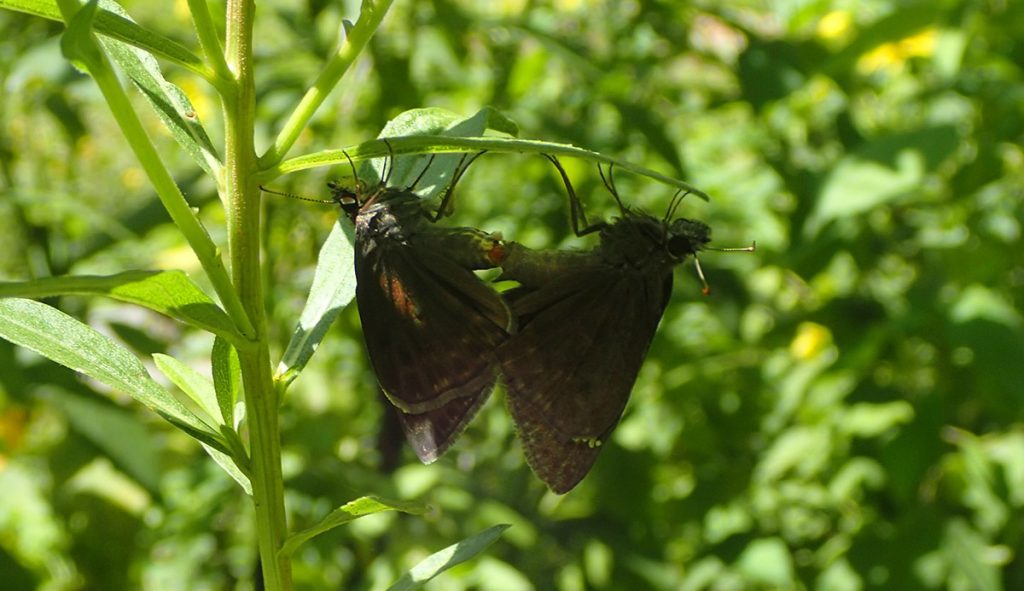On Season 1 of Local Routes, we plunged into the wild spaces of the Red Hills in search of native butterfly species. Over this last summer, WFSU Producer Rob Diaz de Villegas had an outbreak of monarch caterpillars in his yard. These experiences sparked an interest in what it takes to create a butterfly habitat in the home. Lilly Anderson-Messec manages Native Nurseries in Tallahassee and is an expert in creating pollinator gardens. She shared some of her knowledge with us.
The music in this segment was composed for WFSU by Hot Tamale (Appropriately, they’ll be playing at the Monarch Festival: October 22 on the St. Marks Refuge). We’ll continue to use local music to score EcoAdventures throughout season 2 of Local Routes. Also this season: performances by the Currys, the Adventures of Annabelle Lyn, Langtry, and more!
Rob Diaz de Villegas WFSU-TV
If you invite bees and butterflies into your garden, they will come.
If you have any sort of plants in your backyard, you’ve already invited insects. Living in Florida, we have little choice in the matter. However, each insect has specific plants with which it has ecological relationships. Plant the right flowers or native shrubs, and you’ll see more and more of the colorful pollinators that work our veggie plants and brighten our gardens.
It’s nice to see butterflies in the garden. But there’s so much more insect life to appreciate, especially if you like creepy-crawlies. I, for instance, find caterpillars fascinating. Every time I see a half-eaten leaf, the hunt begins. Some caterpillars are better camouflaged then others, and some of the more insidious pests are nocturnal. It’s not unusual for me to take to the garden with headlamp after the kids are asleep.
Once I find them, the next step is learning what they are.
Knowing what caterpillars species I have helps me decide how I feel about them. Sometimes, butterfly larvae eat your food plants. Long-tailed skipper caterpillars are called bean rollers, and they will eat your bean plants. Likewise, you may see bird poop crawling on your citrus plants. This is a giant swallowtail caterpillar.
By allowing these little guys to tear up your garden a little, you ensure that you’ll keep seeing butterflies. And, it’s kind of amazing to see the butterfly life cycle in action- especially if you have kids.
However, I did plant those fruit and veggie plants to feed myself and my family. And what about moth caterpillars? Some of them actually look pretty cool, and moths have their ecological role to play as well. But they can be so destructive.
These are some of the topics I discussed with Lilly Anderson-Messec at Native Nurseries in Tallahassee. Primarily, though, we talked about building a garden specifically for pollinators. She gave me much too much information for a video, but with a little more space on this blog post, we can further explore key concepts and some good tips that will make your yard a healthy and attractive habitat.
Butterfly Food: Larval vs. Nectar Plants
We know butterflies like flowers. Flowers contain nectar, which is, of course, butterfly food. Adult butterfly food.
What we don’t always think about is what caterpillars eat.
We like having flowers in our yards; they’re pretty with or without butterflies nectaring on them. But those aren’t always the plants that caterpillars need.
Larval plants are beneficial for a couple of reasons. For one, it attracts more adult butterflies to your garden. Mommies have to lay their eggs, and so they seek out the plants their caterpillars eat. Lilly recommends planting these in threes, as it increases the likelihood of butterflies smelling them.
If you’re lucky, you can see butterflies lay their eggs. This summer in my garden, I saw a monarch on our milkweed. I zoomed in from a short distance away to take the photo at the top of the post. When she left, I turned some leaves over and saw little white eggs.
It’s a great thing to witness. Butterflies lay eggs; caterpillars hatch, eat, and grow. They make chrysalides and one day, you have another adult butterfly. It’s satisfying to be able to facilitate this cycle, and help a butterfly species continue. Since every butterfly species in our area (aside from monarchs) stays within two miles of where they hatch, you’ll see more adults by feeding their caterpillars.
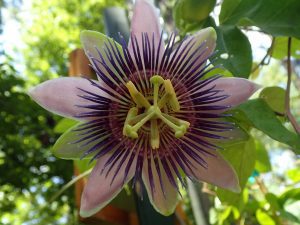
Passionvine offers the best of both worlds- a stunning flower as a nectar source and leaves that are larval food for gulf fritillaries and zebra longwings.
Each species prefers a specific set of plants. Zebra longwings like fire bush and passionvine. Gulf fritillaries like passionvine as well. Fennel and dill host black swallowtails. And, as we all know, milkweed is both a nectar and larval food plant for monarchs.
Native Nurseries offers workshops on butterfly gardening and native plants; and displays information about plants and what species use them. There are online resources as well:
Selecting Larval Plants | Online Resources
There are a couple of handy web resources that can help you figure out what larval food plants you might want for your garden.
If there are certain butterfly species that you see in your area or that you’d like to target, the University of Florida’s IFAS Extension has compiled a list of butterflies found in Florida, and what plants their caterpillars eat.
Or, instead, you can assess the conditions in your yard and find the plants that best fit. The Florida Native Plant Society has a tool that lets you enter your county, the level of sunlight you receive, and soil type. From that information, along with the type of plants you’re looking for (larval food, showy flowers, etc.), it generates a list of native plants.
A Few Notes on Nectar Plants
Butterflies are generally less choosy about their nectar sources than caterpillars are about the leaves they eat. However, Lilly did have some tips for selecting flowering plants.
- Composite flowers. As Lilly tells us in the video, composites are flowers that contain multiple blooms, so pollinators use less energy to eat more nectar. You see many species of butterfly nectaring on Pentas in the video; Pentas bloom in clusters and are a favorite of my backyard insects. And, looking out my back window after Hurricane Hermine, I saw a hummingbird sipping nectar from Pentas in the backyard (I was too slow with the camera, though). Other composites include sunflowers and ironweed.
- Use native plants. Natives are used to our soils and climate, which makes them more likely to survive here. And, of course, our native butterflies have used these plants for thousands of years.
- Also, why not mix in some non-natives. Those Pentas that pollinators love are tropical plants. They bloom longer than many natives, many of which peak in the spring or in the fall. Also, being tropical, they are well suited for Florida heat.
- Beware of “pest safe” plants. “You buy a Pentas at a big box store” Lilly tells us, “And it comes with a little label that says ‘This plant has been sprayed for your protection… or the protection of the plant'” It had become common practice for stores to use neonicotinoid pesticides, in an effort to safeguard your garden from pests like aphids or white flies. However, the pesticides don’t know the difference between pests and pollinators. After public awareness began to increase about neonicotinoids, some chains, like Home Depot, have announced that they intend to phase them out.

Longtailed skipper butterfly on Pentas. Pentas are by far the favorite among butterflies in my garden.
Caterpillars: Pest or Garden Guest?
As we’ve seen, butterflies sometimes use our food plants as larval food. And then there are moth caterpillars. Moths are less appreciated, but have their role to play in our local ecosystems.
Lilly offers a simple solution for those of us who have caterpillars eating our crops. “We’ll plant a plot for the butterflies, and we’ll plant a plot for us.” Lilly says. “And we just transfer any that we find. You just have to plant enough for both of you.”
And those moths?
“A majority of what we think of as pest caterpillars are moth species.” Lilly says. “Because they’re not showy, and they’re nocturnal, we kind of think of them as beneath the butterflies.” But, “Having them in your yard is something that you want.”
Watering my plants just before dawn one morning, I noticed this leopard moth caterpillar eating a hydrangea. That particular hydrangea is not doing as well as others in my yard. I let the caterpillar be.
Then, there are the guys in the short video below. Those are tersa sphinx moth caterpillars. They are a relative of one of the most hated garden pests, the tobacco horn worm, which eats tomato plants. The tersa, however, uses Pentas as larval food. And butterflies love my Pentas.
I used to squish pest caterpillars. Lilly has a more ecologically sound solution.
“Ninety-seven percent of all American terrestrial birds feed their babies exclusively insects.” Lilly says. “And especially, caterpillars are their favorite food.”
So, if you have a pest caterpillar, and a bird feeder, that caterpillar can still fulfill its role at the bottom of the backyard food web.
Surprise Milkweed
Over the summer, I posted a video of some monarchs we raised in my house, the first six of what would end up being over 50 caterpillars we fed and watched grow. You see some of those in the video above.
To feed that initial group, I needed more milkweed plants than I had in my yard. With each wave of caterpillars, four total, I bought more plants. Then, the milkweed started reproducing.
First, I’d see a weed that had a leaf pattern similar to the milkweed.
It looked similar, but I’m not an expert. Luckily, there’s an easy way to find out whether it’s a milkweed.
Look, milk! And, as we’ve seen, it is definitely a weed. No mystery to that plant name. The plant below sprouted in a pot next to a tomato plant. It grew all of eight leaves before a monarch found it and laid an egg there.
When the caterpillar was done eating those leaves, I transferred it to another plant. Its leaves have since grown back. Another, larger one of these surprise milkweeds has hosted several monarch caterpillars.
Milkweed isn’t the only weed I let grow. I mow around wildflowers on my lawn. I leave almost anything that flowers alone. It’s free nectar, and bees and butterflies don’t care how much you paid for it. If you’re worried about invasives, EDDMapS (Early Detection & Distribution Mapping System) has a database.
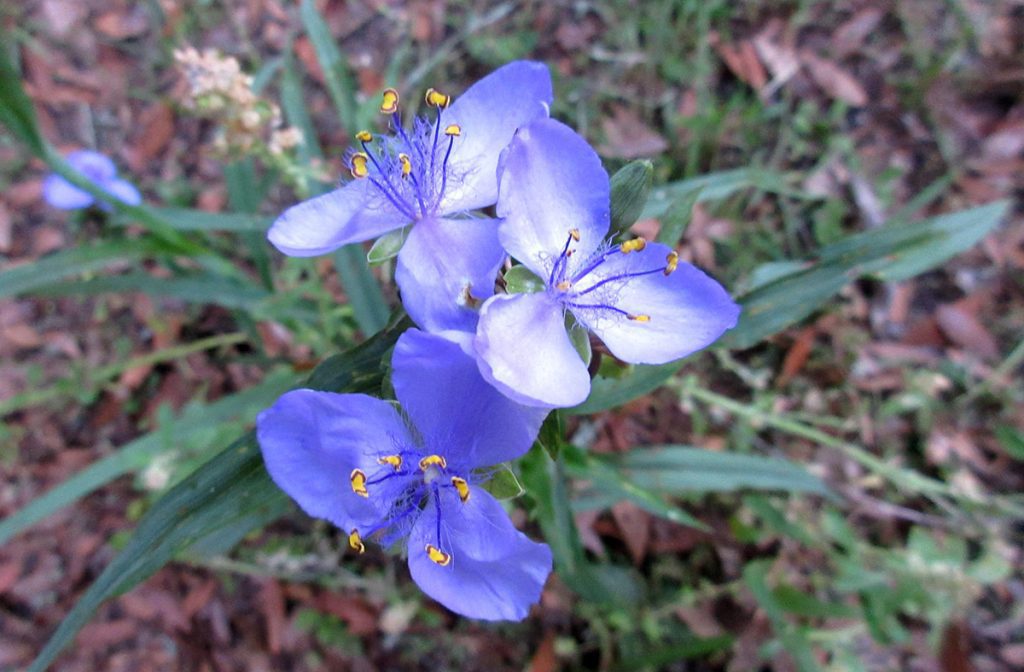
Spiderwort grows in disturbed areas. The mowing of a lawn is a disturbance to that ecosystem, so this flower often grows there. Mowing around them adds free nectar to your home habitat.
Tropical vs. Native Milkweed
Some of you may have read a blog post in the Democrat earlier this week about planting native milkweed. I have a combination of natives and tropical milkweed, mostly because when I had a lot of caterpillars to feed, tropical milkweed plants I saw at Native Nurseries had many more leaves (this changed towards the end of our last round of caterpillars- pink swamp milkweed can be very leafy). The blog post called tropical milkweed invasive. It is. But knowing what you have lets you decide how to manage it.
If you have any tropical milkweed, you’ll want to cut it back in the coming weeks (by Thanksgiving), and keep cutting it to six inches until spring. This will prevent it from flowering in the winter. We don’t want out of season milkweed flowers keeping monarchs from migrating to their wintering grounds.
Also, there’s OE. Ophryocystis elektroscirrha (OE) is a protozoan parasite that infects adult monarch butterflies and their offspring. OE accumulates on tropical milkweed flowers over time, and can be combated by clipping those flowers back in the fall. Native milkweed flowers will naturally die off at this time, making them more resistant to OE.
Over the summer, I noticed more and more species of native milkweed available. I’ve spent a lot of money on milkweed plants, and now have a lot of little plants growing free of cost. But I’d also like to go entirely native. I’ll have to think about the best balance of feasible and sustainable as I approach the next spring monarch migration.
Native Bees & Other Beneficial Insects
 The focus of the video and most of this blog post is butterflies. But, zooming in with my camera and taking a closer look, I’ve started noticing a lot of cool looking native bees as well.
The focus of the video and most of this blog post is butterflies. But, zooming in with my camera and taking a closer look, I’ve started noticing a lot of cool looking native bees as well.
The first time I saw an image of a blue metallic bee, it was in a display of carnivorous plants found in the Apalachicola National Forest. I thought it must be some exotic deep woods creature, pollinating flowers in pine flatwoods or savannahs. Imagine my surprise when I saw one in my purslane flowers. The more I looked, the more of these native metallic “sweat” bees in my flowers- you see two in the video.
To me, that’s a big part of the adventure of gardening. Like caterpillars and butterfly eggs, the many insects that populate a garden are evidence of a rich ecosystem. Many of my milkweed plants have these little orange bugs on them- milkweed (or oleander) aphids. I looked them up and they don’t seem to be of any harm to monarchs, so I let them be. Then, one day, I saw this little guy eating them.
It’s the larva of the syrphid fly, which, as an adult, mimics the look of a bee. I sat and watch it hunt aphids for a while.
Think about it. Your backyard has hundreds, maybe thousands of insects in it. They eat each other, or get eaten by birds. They spin chrysalides and metamorphose. Some of them are colorful or have elaborate patterns; others look kind of weird. A whole lot of life and biology is happening that you won’t notice unless you start looking for it.
Plant and Animal Species Seen in the Video
0:04 Zebra longwing, also known as zebra heliconian (Heliconius charithonia tuckeri), nectaring on a red Pentas (Pentas is the genus name for several related flowers).
0:09 Brownbelted bumble bee (Bombus griseocollis) on dotted horsemint (Monarda punctata). These are my best guesses- feel free to correct me if I’m wrong!
0:12 Monarch butterfly (Danaus plexippus) on pink Pentas.
0:16 Longtailed skipper (Urbanus proteus) on Hardy red gloxinia (Sinningia sellovii)
0:20 Carolina chickadee (Poecile carolinensis) on a bird feeder.
0:24 Monarch butterfly chrysalis.
0:26 Metallic green sweat bee (Agapostemon genus).
0:29 Gulf Fritillary (Euploieta claudia) on pink Pentas.
0:36 Brownbelted bumble bee on bluewing, AKA wishbone flowers (Torenia fournieri).
0:48 Morning glory (Ipomea genus) flowers.
0:52 Longtailed skipper and black carpenter bee (best guess) on pink Pentas.
0:55 Golden alexander (Zizia aurea), flowering.
0:59 Monarch caterpillars eating tropical milkweed (Asclepias curassavica) leaves.
1:02 Monarch caterpillar (1st instar) and monarch egg on milkweed.
1:15 Passionvine (Passiflora incarnata).
1:29 Green bean plant with caterpillar damage.
1:31 Longtailed skipper caterpillar on green bean plant.
1:33 Parsley.
1:34 Fennel.
1:38 Black Swallowtail (Papilio plynexus asterius) caterpillar on fennel.
1:51 Green bean leaf with curl. This is evidence of a long tailed skipper caterpillar, known as a bean roller for the shelters they create on bean plant leaves.
1:55 Coneflower, pink petals.
2:01 Zebra longwing on sweet almond bush (Aloysia virgata).
2:09 Starry silphium (Silphium asteriscus), a Florida native sunflower.
2:12 Brownbelted bumble bee on starry silphium.
2:29 Longtailed skipper on pink Pentas.
2:32 White swamp milkweed (Asclepias perennis), a native milkweed.
2:36 Meadow parsnip (Thaspium barbinode).
2:40 Firebush (Hamelia patens) with zebra longwing.
2:44 Cloudless sulphur (Phoebis sennae) on firebush.
2:48 Brownbelted bumblebee on pink Pentas.
2:53 Silver-spotted skipper (Epargyreus clarus) on pink Pentas.
2:57 Zebra longwing on red Pentas.
3:05 Small, dark metallic sweat bee on green purse lane (Portulaca oleracea) flower.
3:08 Okra flower, with southern army worm (Spodoptera eridania, a moth caterpillar) eating it from below.
3:13 Two southern cloudywings (Thorybes bathyllus) mating, with a third trying to break in. The lighting under that leaf isn’t great in this shot, but that’s my best guess at the species.
3:19 Zebra longwing with a damaged wing, sunning.
Come adventure with us in the Red Hills, Apalachicola River and Bay, the Forgotten Coast, and More! Subscribe to the WFSU Ecology Blog by Email.
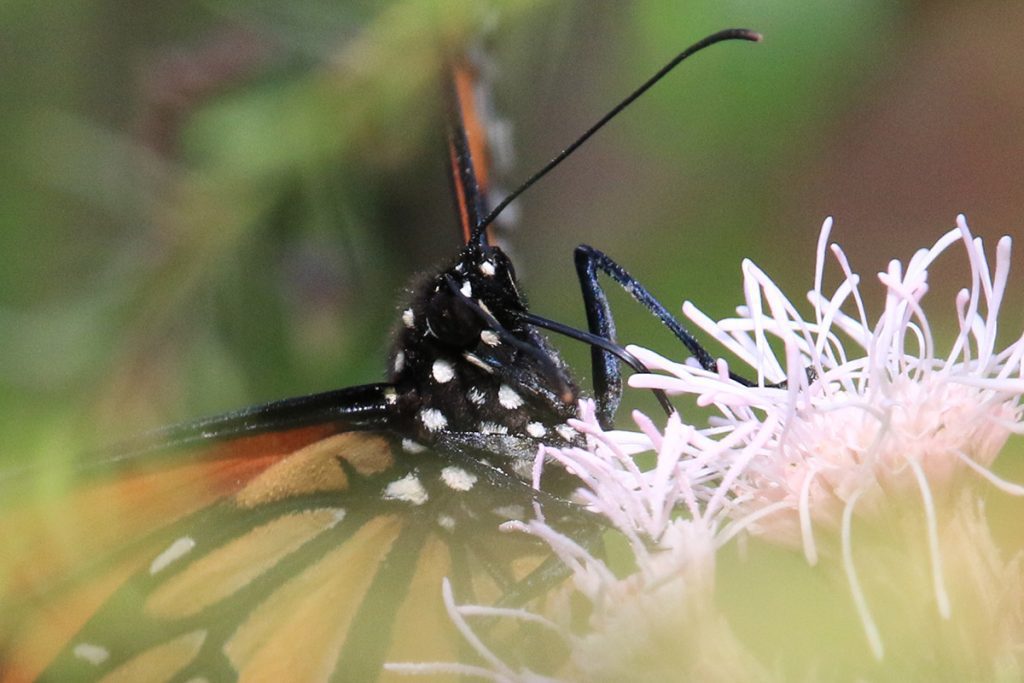
Dig Deeper into Backyard Ecology
What can we do to invite butterflies, birds, and other wildlife into our yards? And what about the flora and fauna that makes its way into our yards; the weeds, insects, and other critters that create the home ecosystem? WFSU Ecology Blog takes a closer look.

